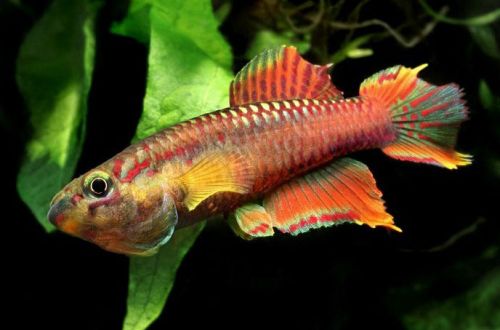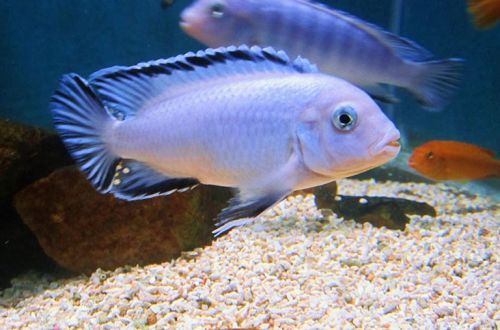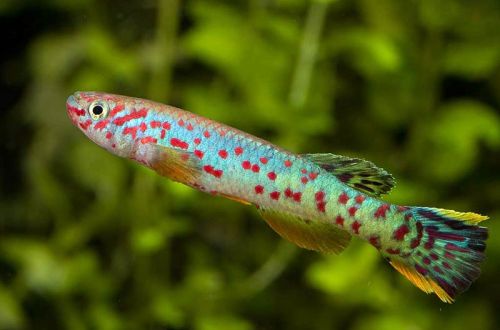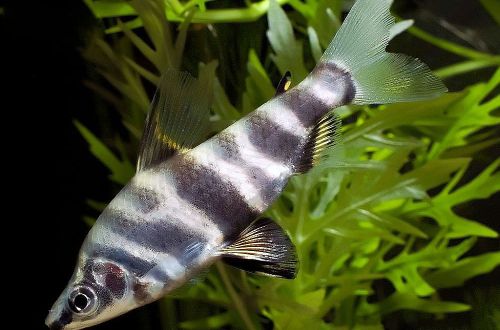
Afiosemion Splendid
Aphiosemion Splendid, scientific name Aphyosemion splendopleure, belongs to the Nothobranchiidae family. The fish attracts attention with its original body color, in which it is difficult to distinguish any dominant color (this applies only to males). It is distinguished by a peaceful disposition and relative ease of maintenance, however, breeding at home will require a lot of time and effort. This explains the low prevalence of this species in the aquarium trade, it can only be found in professional breeders, in large pet stores or from enthusiasts via the Internet.

Contents
Habitat
The habitat extends along the equatorial coast of West Africa in the territories of modern Cameroon, Equatorial Guinea and Gabon. The fish can be found in small tributaries of rivers, slow-flowing streams flowing in the canopy of an evergreen moist forest.
Description
When looking at a male and a female, it will be difficult to believe that they belong to the same species, their external differences are so strong. Males differ not only in size and enlarged fins, but also in amazingly beautiful colors that can combine all the colors of the rainbow. Depending on the specific region of origin, one of the colors may prevail over the others. Females have a simple structure without frilly fins and a modest gray color.
Food
Individuals grown in an artificial aquarium environment are completely undemanding to eat and will accept all types of dry food, provided that they contain a significant amount of protein. You can diversify the diet with live or frozen products from daphnia, brine shrimp, bloodworms. Feed 2-3 times a day in the amount eaten in 5 minutes, uneaten leftovers should be removed in a timely manner.
Maintenance and care
A spacious aquarium (at least 50 liters), decorated in the image of a natural habitat, will be a great place for a group of Afiosemion Splendida. Optimum substrate based on peat or similar, slight silting may occur over time – this is normal. The main emphasis is on plants both rooted and floating, they should form densely planted areas. Shelters in the form of snags, branches or pieces of wood are also welcome.
Water conditions are slightly acidic pH and mild to medium hardness. The range of acceptable pH and dGH values is not wide enough to be able to fill an aquarium without prior water treatment. Therefore, before using tap water, check its parameters and, if necessary, adjust them. Read more about pH and dGH parameters and how to change them in the “Hydrochemical composition of water” section.
The standard set of equipment includes a heater, an aerator, a lighting system and filtration. The latter is placed in such a way that the water streams leaving the filter do not create excessive current, since the fish do not tolerate it well. If the jet is directed at an obstacle (tank wall, snag, etc.), it will be possible to significantly reduce its energy, thereby weakening or even eliminating the internal flow.
In a balanced biological system, aquarium maintenance is reduced to weekly replacement of part of the water (10–15% of the volume) with fresh and regular cleaning of the soil from fish waste. As necessary, organic deposits are removed from the glass with a scraper.
Behavior and Compatibility
Intraspecific relationships are built on the competition of males for the attention of females. Adult males become territorial and often fight each other, fortunately serious injuries are extremely rare. However, keeping them together should be avoided, or sufficient space should be provided for males at the rate of 30 liters each. The optimal combination is 1 male and several females. In relation to other species, Afiosemion Splendid is peaceful and even shy. Any active fish can easily intimidate him. As neighbors, calm species of a similar size should be selected.
Breeding / breeding
Spawning is recommended to be carried out in a separate tank in order to protect the offspring from their own parents and other aquarium neighbors. As a spawning aquarium, a small capacity of about 10 liters is suitable. Of the equipment, a simple sponge airlift filter, a heater and a lamp for lighting are sufficient.
In the design, you can use several large plants as decoration. The use of a substrate is not recommended for ease of further maintenance. At the bottom, you can place a finely meshed mesh through which the eggs can pass. This structure is explained by the need to ensure the safety of eggs, since parents are prone to eating their own eggs.
A selected pair of adult fish is placed in a spawning aquarium. The stimulus for reproduction is the establishment of a water temperature in the range of 21–24 ° C, a slightly acid pH value (6.0–6.5) and the inclusion of live or frozen meat products in the daily diet. Be sure to clean the soil from food residues and organic waste (excrement) as often as possible, in a cramped space, water quickly becomes contaminated.
The female lays eggs in portions of 10–20 once a day for two weeks. Each portion of eggs should be carefully removed from the aquarium (this is why no substrate is used) and placed in a separate container, for example, a tray with high edges to a water depth of only 1-2 cm, with the addition of 1-3 drops of methylene blue, depending on the volume . It prevents the development of fungal infections. Important – the tray should be in a dark, warm place, the eggs are extremely sensitive to light. The incubation period lasts about 12 days. Another way is to place the eggs in moist, even damp peat at the same temperature and in complete darkness. The incubation period in this case increases to 18 days.
Juveniles also appear not at a time, but in batches, newly appeared fry are placed in a spawning aquarium, where at that time their parents should no longer be. After two days, the first food can be fed, which consists of microscopic organisms such as brine shrimp nauplii and slipper ciliates. In the second week of life, live or frozen food from brine shrimp, daphnia, etc. is already used.
Just as during the spawning period, pay great attention to the purity of the water. In the absence of an effective filtration system, you should regularly clean the spawning aquarium at least once every few days and replace some of the water with fresh water.
Fish diseases
The well-being of the fish is guaranteed in an aquarium with a well-established biological system under suitable water conditions and proper nutrition. Violation of one of the conditions will significantly increase the risk of diseases, since the vast majority of ailments are directly related to the conditions of detention, and diseases are only consequences. Read more about symptoms and treatments in the Aquarium Fish Diseases section.





